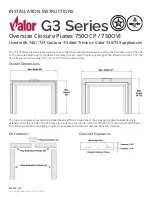
31
BURNER CALIBRATION
The optimum calibration of the burner requires
an analysis of the flue gases at the boiler outlet.
Adjust successively:
1 - First firing output
2 - 1st stage burner output
3 - 2nd stage burner output
4 - Air pressure switch
5 - Minimum gas pressure switch
1 - FIRING OUTPUT
According to EN 676 Regulations:
Burners with max. output up to 120 kW
Firing can be performed at the maximum opera-
tion output level. Example:
• Max. operation output
: 120 kW
• Max. firing output
: 120 kW
Burners with max. output above 120 kW
Firing must be performed at a lower output than
the max. operation output. If the firing output
does not exceed 120 kW, no calculations are
required. If firing output exceeds 120 kW, the
regulations prescribe that the value be defined
according to the control box safety time "ts":
• for "ts" = 2s, firing output must be equal to or
lower than 1/2 of max. operation output.
• For "ts" = 3s, firing output must be equal to or
lower than 1/3 of max. operation output.
Example: MAX operation output of 600 kW.
Firing output must be equal to or lower than:
• 300 kW with "ts" = 2s
• 200 kW with "ts" = 3s
In order to measure the firing output:
- Disconnect the plug-socket 15)(A)p.8 on the
ionization probe cable (the burner will fire and
then go into lock-out after the safety time has
elapsed).
- Perform 10 firings with consecutive lock-outs.
- On the meter read the quantity of gas burned.
This quantity must be equal to or lower than the
quantity given by the formula:
Example for G 20 gas (10 kWh/Nm
3
):
Max. operation output: 600 kW corresponding to
60 Nm
3
/h.
After 10 firings with lock-outs, the delivery read
on the meter must be equal to or lower than:
60 : 360 = 0,166 Nm
3
.
2 - 2ND STAGE OUTPUT
MIN gas setting
Measure gas delivery at the meter.
- If it is to be reduced, close the 1st stage gas
valve a little.
- If it is to be increased, first open the 1st stage
gas valve all the way and then, if it is not
enough, increase the gas pressure coming
from the pressure governor.
MIN air setting
Operate the orange lever of the servomotor to
optimize the ratio between the quantity of air and
gas.
This is particularly important when the burner is
set for two stage operation.
Then close load control TR, or insert the jumper.
The servomotor will complete the rotation by
opening the air gate valve and the stage 2 gas
valve.
There must be no jerks or pulsations in the pas-
sage from stage 1 to stage 2.
Nm
3
/h (max. burner delivery
)
360
REGLAGE BRULEUR
Pour obtenir un réglage optimal du brûleur, il faut
effectuer l'analyse des gaz d'échappement de la
combustion à la sortie de la chaudière.
Régler en succession:
1 - Puissance à l'allumage:
2 - Puissance brûleur en 1ère allure
3 - Puissance brûleur en 2ème allure
4 - Pressostat air
5 - Pressostat seuil minimum du gaz
1 - PUISSANCE A L'ALLUMAGE
Selon la norme EN 676 :
Brûleurs avec puissance MAX jusqu'à 120 kW
L'allumage peut se faire à la puissance maxi-
mum de fonctionnement. Exemple:
•
Puissance maximum de fonctionnement : 120 kW
•
Puissance maximum à l'allumage
: 120 kW
Brûleurs avec puissance MAX supérieure à 120 kW
L'allumage doit se faire à une puissance réduite
par rapport à la puissance maximum de fonction-
nement.
Si la puissance à l'allumage ne dépasse pas 120
kW, aucun calcul n'est nécessaire. Au contraire,
si la puissance à l'allumage dépasse 120 kW, la
norme établit que sa valeur soit définie en fonc-
tion du temps de sécurité "ts" du coffret de sécu-
rité:
•
pour "ts" = 2s la puissance à l'allumage doit
être égale ou inférieure à 1/2 de la puissance
maximum de fonctionnement.
•
pour "ts" = 3s la puissance à l'allumage doit
être égale ou inférieure à 1/3 de la puissance
maximum de fonctionnement.
Exemple: puissance MAX de fonctionnement
600 kW.
La puissance à l'allumage doit être égale ou in-
férieure à:
•
300 kW avec "ts" = 2s
•
200 kW avec "ts" = 3s
Pour mesurer la puissance à l'allumage:
- Débrancher la fiche-prise 15)(A)p.8 sur le câ-
ble de la sonde d'ionisation (le brûleur s'allume
et se bloque après le temps de sécurité).
- Exécuter 10 allumages avec blocages consé-
cutifs.
- Lire au compteur la quantité de gaz brûlée.
Cette quantité doit être égale ou inférieure à
celle donnée par la formule:
Exemple pour du gaz G 20 (10 kWh/Nm
3
):
Puissance maximum de fonctionnement, 600 kW
correspondants à 60 Nm
3
/h.
Après 10 allumages avec blocage le débit lu au
compteur doit être égal ou inférieur à:
60 : 360 = 0,166 Nm
3
.
2 - PUISSANCE BRULEUR EN 1ERE ALLURE
Réglage gaz MIN
Mesurer le débit du gaz au compteur.
- S'il faut la réduire, fermer un peu la vanne du
gaz de 1ère allure.
- S'il faut l'augmenter ouvrir d'abord entièrement
la vanne du gaz de 1ère allure et ensuite, si ça
ne suffit pas, augmenter la pression du gaz à la
sortie du régulateur de pression.
Réglage air MIN
Intervenir sur le levier orange du servomoteur
pour proportionner le mieux possible la quantité
d'air avec celle du gaz.
Cette opération est très importante quand le brû-
leur est prévu pour fonctionner à deux allures.
Fermer ensuite la télécommande TR, ou placer
un ponter.
Le servomoteur complètera la rotation en
ouvrant le volet d'air et la vanne gaz de 2ème al-
lure.
Le passage entre la 1ère et la 2ème allure doit
se faire sans à-coups ou pulsations.
Nm
3
/h (débit max. brûleur)
360














































